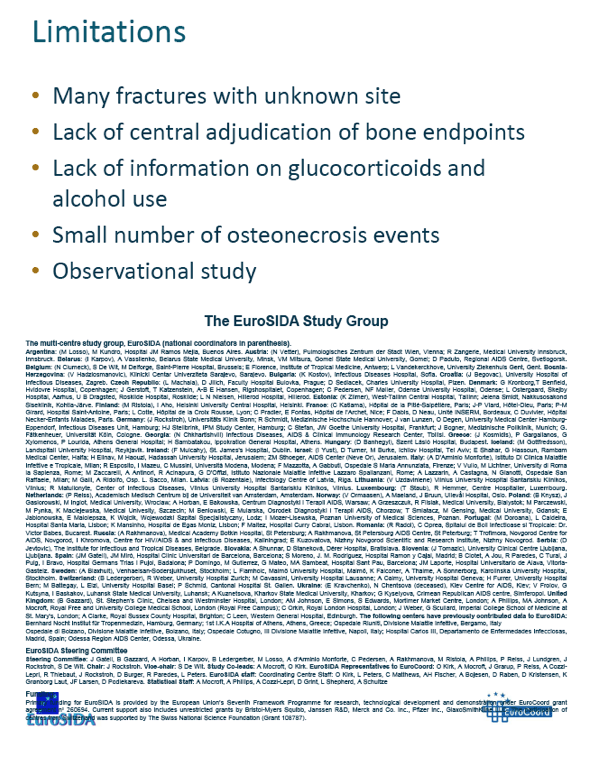 |
 |
 |
| |
Antiretrovirals, fractures and osteonecrosis in a large European HIV cohort - EuroSIDA........TDF Is Only Antiretroviral Implicated in EuroSIDA Fracture Study
|
| |
| |
Conference on Retroviruses and Opportunistic Infections (CROI), February 22-25, 2016, Boston
"HIV+ persons have 1.5-3.0-fold greater risk of fractures"
Mark Mascolini
WEBCAST link: http://www.croiwebcasts.org/console/player/29447?mediaType=audio&
Alone among antiretrovirals assessed, tenofovir disoproxil fumarate (TDF) independently boosted risk of incident fracture, according to results of a 12,000-person EuroSIDA analysis [1]. The study linked other antiretrovirals, including lopinavir/ritonavir, to osteonecrosis, but not after adjustment for use of other risky antiretrovirals.
The EuroSIDA team noted that people with HIV have up to a 3-fold higher risk of fracture than the general population and as much as a 100-fold higher risk of osteonecrosis. To shed more light on possible links between specific antiretrovirals, other variables, and fracture or osteonecrosis, they focused on EuroSIDA participants older than 16, with follow-up after January 1, 2004, and with baseline CD4 and viral load data.
Among the 11,820 EuroSIDA members included, 496 had 619 new fractures for an incidence of 7.2 per 1000 person-years. Of these 619 fractures, 132 (21%) were judged osteoporotic. Almost half of the fractures involved the arm or leg. Osteonecrosis developed in 73 people for an incidence of 1.0 per 1000 person-years.
Fracture incidence proved higher at lower current CD4 counts: 8.9 per 1000 person-years at a count of 200 or lower, 7.5 at 351 to 500 CD4s, and 5.0 at a count above 750. Osteonecrosis incidence did not vary much with current CD4 count (1.0 per 1000 person-years at a CD4 count of 200 or lower and 0.8 at a count above 750).
Poisson regression analysis identified several demographic and clinical factors independently associated with a higher risk of any fracture: older age, body mass index below 18 kg/m(2), HIV infection during injection drug use, HCV positivity, prior osteonecrosis, prior fracture, non-AIDS cancer within 12 months, and cardiovascular disease within 12 months. Two factors independently predicted a lower fracture risk: race other than white, and every 2-fold higher current CD4 count. Race other than white also independently predicted lower osteonecrosis risk, while four factors predicted a higher osteonecrosis risk: prior osteonecrosis, prior fracture, prior AIDS (excluding cancer), and prior AIDS cancer.
Ever using TDF boosted the risk of any fracture about 40%, while current TDF upped the risk about 25%. Every 5 years of TDF raised fracture risk in univariate analysis but not multivariate analysis. TDF had no independent impact on osteoporotic fracture risk.
In an analysis that considered each antiretroviral separately plus other risk factors, any exposure to five antiretrovirals independently inflated the risk of osteonecrosis: didanosine, indinavir, saquinavir, lopinavir/ritonavir, and TDF. But when the analysis mutually adjusted for use of the other antiretrovirals, none of these five drugs independently predicted osteonecrosis.
The EuroSIDA investigators noted that their analysis is limited by lack of central adjudication of bone endpoints, lack of information on glucocorticoid and alcohol use, and the small number of osteonecrosis cases that developed.
Reference
1. Borges AH, Hoy J, Florence E, et al. Antiretrovirals, fractures, and osteonecrosis in a large European HIV cohort. Conference on Retroviruses and Opportunistic Infections (CROI), February 22-25, 2016, Boston. Abstract 46.








|
| |
|
 |
 |
|
|